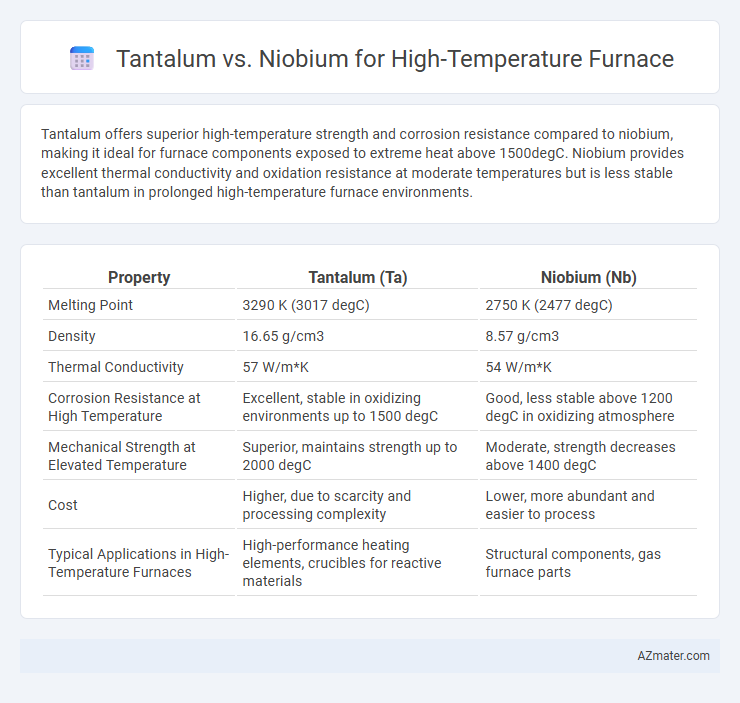Tantalum offers superior high-temperature strength and corrosion resistance compared to niobium, making it ideal for furnace components exposed to extreme heat above 1500degC. Niobium provides excellent thermal conductivity and oxidation resistance at moderate temperatures but is less stable than tantalum in prolonged high-temperature furnace environments.
Table of Comparison
| Property | Tantalum (Ta) | Niobium (Nb) |
|---|---|---|
| Melting Point | 3290 K (3017 degC) | 2750 K (2477 degC) |
| Density | 16.65 g/cm3 | 8.57 g/cm3 |
| Thermal Conductivity | 57 W/m*K | 54 W/m*K |
| Corrosion Resistance at High Temperature | Excellent, stable in oxidizing environments up to 1500 degC | Good, less stable above 1200 degC in oxidizing atmosphere |
| Mechanical Strength at Elevated Temperature | Superior, maintains strength up to 2000 degC | Moderate, strength decreases above 1400 degC |
| Cost | Higher, due to scarcity and processing complexity | Lower, more abundant and easier to process |
| Typical Applications in High-Temperature Furnaces | High-performance heating elements, crucibles for reactive materials | Structural components, gas furnace parts |
Introduction to Tantalum and Niobium
Tantalum and niobium are refractory metals known for their exceptional resistance to high temperatures and corrosion, making them ideal for high-temperature furnace applications. Tantalum boasts a melting point of 3017degC and excellent chemical stability, while niobium offers a melting point of 2477degC and good thermal conductivity. Both metals are widely used in furnace components requiring durability and performance under extreme heat conditions.
Chemical and Physical Properties Comparison
Tantalum exhibits superior corrosion resistance and a higher melting point of approximately 3017degC, making it ideal for high-temperature furnace applications where chemical stability is critical. Niobium, with a melting point around 2477degC and excellent ductility, offers advantageous thermal conductivity but lower resistance to oxidation compared to tantalum. The density of tantalum (16.65 g/cm3) surpasses that of niobium (8.57 g/cm3), influencing furnace component weight and thermal inertia during high-temperature operations.
Melting Points and Thermal Stability
Tantalum, with a melting point of approximately 3017degC, exhibits superior thermal stability compared to niobium, which melts at around 2477degC. This higher melting point makes tantalum more suitable for high-temperature furnaces requiring materials that can withstand extreme heat without deforming. Niobium's lower melting point limits its use in such environments, although it offers good thermal stability at moderately high temperatures.
Oxidation Resistance at High Temperatures
Tantalum exhibits superior oxidation resistance compared to niobium at high temperatures, maintaining structural integrity up to approximately 1500degC due to the formation of a stable tantalum pentoxide (Ta2O5) protective layer. Niobium tends to oxidize more rapidly above 800degC, forming niobium oxides that can spall and degrade the material. For high-temperature furnace applications, tantalum's enhanced oxidation resistance significantly extends component lifespan and performance reliability.
Mechanical Strength and Durability
Tantalum exhibits superior mechanical strength at high temperatures, maintaining structural integrity up to 3000degC, making it highly durable for furnace applications exposed to extreme heat. Niobium, while offering good strength and corrosion resistance, has a lower melting point of about 2477degC, limiting its use in ultra-high-temperature environments. The exceptional creep resistance and oxidation resistance of tantalum contribute to longer service life and reliability in high-temperature furnace components compared to niobium.
Fabrication and Machinability Differences
Tantalum exhibits superior high-temperature strength and corrosion resistance compared to niobium, making it ideal for furnace components exposed to extreme conditions. However, niobium offers better machinability due to its lower melting point and softer nature, reducing fabrication time and tool wear. Fabrication processes for tantalum require more specialized equipment and slower machining speeds to avoid work hardening and tool damage.
Cost Analysis and Market Availability
Tantalum exhibits superior high-temperature corrosion resistance but commands a significantly higher cost, often exceeding niobium's price by 3 to 5 times, primarily due to its scarcity and complex extraction processes. Niobium offers a more affordable alternative with adequate performance in high-temperature furnace applications, benefiting from broader market availability and established supply chains, particularly sourced from Brazil and Canada. Cost-efficiency analysis favors niobium for large-scale industrial use, while tantalum is reserved for specialized applications demanding exceptional chemical stability at extreme temperatures.
Applications in High-temperature Furnaces
Tantalum and niobium both exhibit excellent high-temperature stability and corrosion resistance, making them invaluable materials in high-temperature furnace applications such as heating elements, thermocouple sheaths, and furnace linings. Tantalum offers superior resistance to oxidation and carburization at temperatures exceeding 1500degC, ideal for ultra-high temperature environments like vacuum or inert gas furnaces. Niobium provides cost-effective performance with good thermal conductivity and oxidation resistance up to about 1200degC, commonly used in controlled atmospheres for semiconductor and aerospace furnace components.
Pros and Cons of Tantalum vs Niobium
Tantalum offers superior corrosion resistance and high melting point (3017degC), making it ideal for high-temperature furnace applications, but it is significantly more expensive and denser than niobium. Niobium, with a melting point of 2477degC, provides excellent thermal conductivity and lower cost, although it has lower oxidation resistance at extreme temperatures compared to tantalum. The choice between tantalum and niobium hinges on balancing cost efficiency against performance demands in corrosive and ultra-high temperature environments.
Choosing the Right Material for Your Furnace
Tantalum and niobium both exhibit exceptional high-temperature resistance, making them ideal for furnace components exposed to extreme environments above 2000degC. Tantalum offers superior corrosion resistance against molten slags and aggressive atmospheres, while niobium provides enhanced mechanical strength and lower density, optimizing structural integrity under thermal stress. Selecting the right material hinges on balancing corrosion resistance with mechanical performance, aligned to the specific operational conditions of your furnace.

Infographic: Tantalum vs Niobium for High-temperature Furnace
 azmater.com
azmater.com